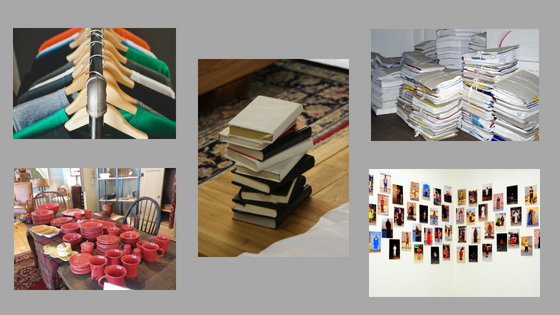In The Life-Changing Magic of Tidying Up, Marie Kondo recommends tidying by category, not by room, and doing so in the following order:
- Clothes;
- Books;
- Papers;
- “Komono,” or Miscellaneous; and
- Sentimental.
In an earlier post, I explained why it is important to tidy by category. But why should you tidy by category in the order recommended by Marie Kondo?
Sometimes, my clients believe that Marie Kondo recommends this order because it progresses from “easiest to hardest.” Therefore, if “komono” is easier for them to start with than clothing, or if books are harder for them to tackle than “komono,” they believe they should rearrange the categories to start with what they view as easiest and go from there.
This approach is unlikely to be successful, because . . .
. . . the categories are not organized from easiest to hardest.
In explaining the categories, Marie Kondo does mention “starting with the easy things first and leaving the hardest for last,” but that only indicates that she made “sentimental” items the last category because they are likely to be hardest. Items from any category can be sentimental — even clothing — so it makes sense that the items we keep for sentimental reasons would be the hardest to let go of. But that does not explain why clothes, books, papers, and komono are in that order.
So why does it work to begin with clothes and continue with books, papers, and komono, ending with sentimental?
Marie Kondo says, in The Life-Changing Magic, that she is “actually not sure why” this order works so well (p.65), but in her many years of experience helping clients, she has found that it does. In my experience, these are some of the reasons that this order works better than others:
1. Unlike some of the categories, clothes are often already kept only in a limited number of places, making the gathering process easier.
Even if some clothes are in an attic, basement, or separate closets, they are often in a limited number of accessible spaces. Gathering can be difficult when the tidying process is just beginning, so it helps to begin with a category that is relatively easy to gather.
2. Early categories are intended to hone your sensitivity to joy. “Low-hanging fruit” like expired toiletries will not do that.
One reason that the KonMari method results in lasting change is that you learn about yourself while you progress through the various categories. By learning about what you like and what is important to you while working through the earlier categories, later categories that could be overwhelming — like komono and sentimental — become easier. If you start with items that are easy to decide to discard — like expired toiletries or expired food items — you are not training yourself to make the harder decisions later on. That makes it easy to rebound when you get to harder categories. On the other hand, if the process becomes easier as you go along, you are more likely to see it through to the end and experience the lasting change that comes from completing the entire “tidying festival.”
3. It is important to see a significant difference from the beginning. Because everyone interacts with clothes on a daily basis, tidying that category brings immediate, noticeable change.
Experiencing noticeable change from the beginning of the process is motivating, and starting with clothes allows everyone to experience a difference right away. Although the same could be true of any room that is used often, such as a kitchen or bathroom, everyone is likely to notice a difference in the ease with which they can store and access their clothes — and choose an outfit that will spark joy — when they have completed the clothing category. A significant difference could also be achieved in the kitchen, for example, but kitchen komono would be an overwhelming place for most people to begin. Although clothing can involve difficult decisions, they are also typically manageable while also offering a dramatic, immediate change.
What about you? Can you think of reasons that the KonMari tidying order makes sense? Let me know in the comments!


Recent Comments